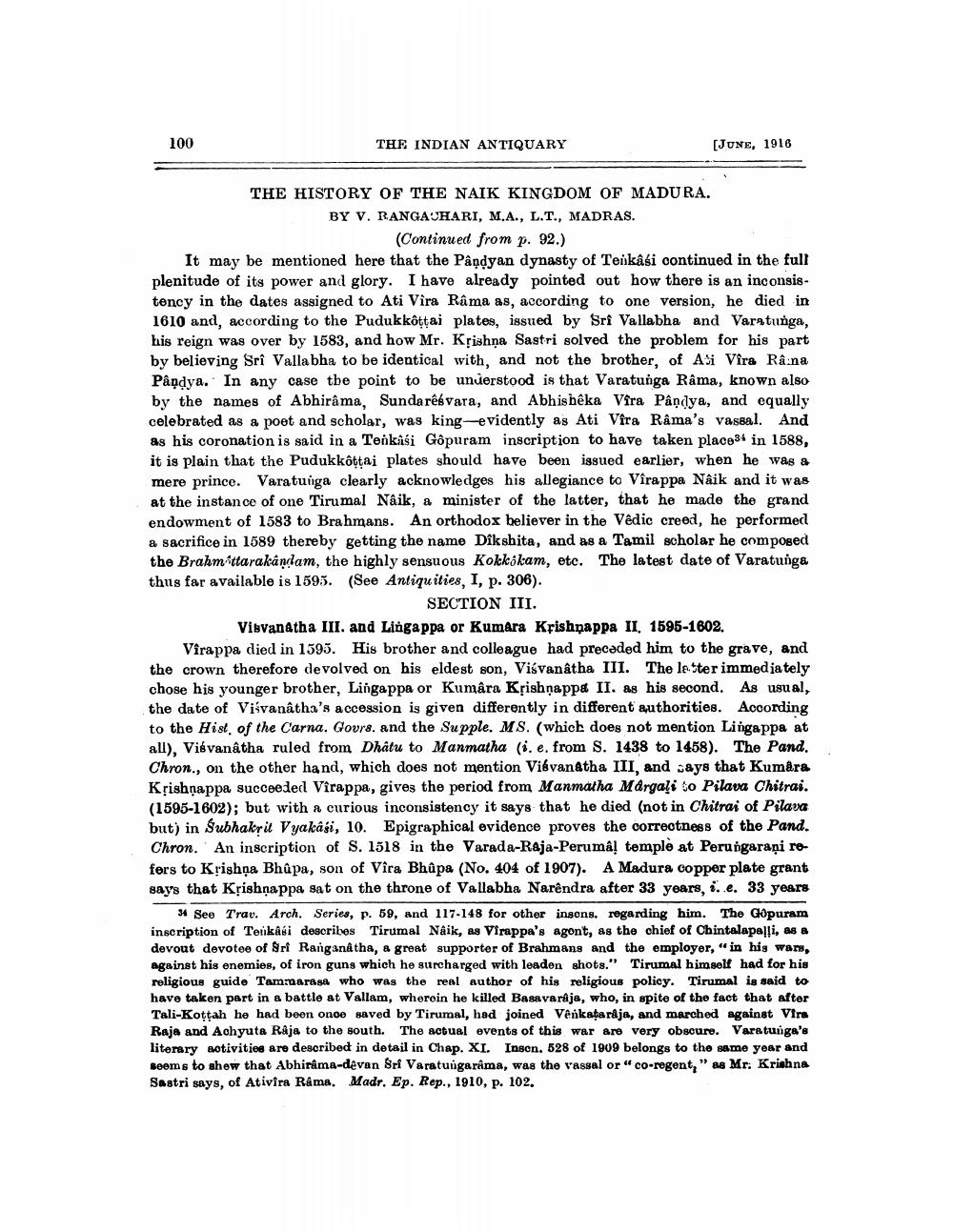________________
100
THE INDIAN ANTIQUARY
[JUNE, 1916
THE HISTORY OF THE NAIK KINGDOM OF MADURA. BY V. RANGASHARI, M.A., L.T., MADRAS.
(Continued from p. 92.) It may be mentioned here that the Pandyan dynasty of Tenkasi continued in the full plenitude of its power and glory. I have already pointed out how there is an inconsistency in the dates assigned to Ati Vira Râma as, according to one version, he died in 1610 and, according to the Pudukkottai plates, issued by Sri Vallabha and Vargtunga, his reign was over by 1583, and how Mr. Krishna Sastri solved the problem for his part by believing Sri Vallabha to be identical with, and not the brother, of ASi Vîra Râina Pandya.. In any case the point to be understood is that Varatunga Rama, known also by the names of Abhirama, Sundarésvara, and Abhisheka Vira Pandya, and equally celebrated as a poet and scholar, was king-evidently as Ati Vira Rama's vassal. And as his coronation is said in a Tenkasi Gôpuram inscription to have taken place34 in 1588, it is plain that the Pudukkottai plates should have been issued earlier, when he was a mere prince. Varatuuga clearly acknowledges his allegiance to Vîrappa Naik and it was at the instance of one Tirumal Naik, a minister of the latter, that he made the grand endowment of 1583 to Brahmans. An orthodox believer in the Vedic creed, he performed a sacrifice in 1589 thereby getting the name Dikshita, and as a Tamil scholar he composed the Brahmittarakandam, the highly sensuous Kokkikam, etc. The latest date of Varatunga thus far available is 1595. (See Antiquities. I, p. 306).
SECTION III. Visvanatha III. and Lingappa or Kumara Krishnappa II. 1595-1602. Virappa died in 1595. His brother and colleague had precaded him to the grave, and the crown therefore devolved on his eldest son, Visvanatha III. The letter immediately chose his younger brother, Lingappa or Kumara Krishnappa II. as his second. As usual, the date of Visvanatha's accession is given differently in different authorities. According to the Hist, of the Carna. Govrs, and the Supple. MS. (which does not mention Lingappa at all). Visvanatha ruled from Dhâtu to Manmatha (i. e. from S. 1438 to 1458). The Pand. Chron., on the other hand, which does not mention Visvanatha III, and says that Kumāra Krishnappa succeeded Vîrappa, gives the period from Manmatha Margali to Pilava Chitrai. (1595-1602); but with a curious inconsistency it says that he died (not in Chitrai of Pilava but) in Subhakrit Vyakási, 10. Epigraphical evidence proves the correctness of the Pand. Chron. An inscription of S. 1518 in the Varada-Raja-Perumal temple at Perungaraṇi refers to Krishna Bhûpa, son of Vira Bhûpa (No. 404 of 1907). A Madura copper plate grant says that Krishnappa sat on the throne of Vallabha Narendra after 33 years, i.e. 33 years
See Trav. Arch. Series, p. 59, and 117-148 for other insons. regarding him. The Gópuram inscription of Terkasi describes Tirumal Naik, as Virappa's agont, as the chief of Chintalapaļli, as & devout devotee of Sri Ranganatha, a great supporter of Brahmans and the employer, “in his wans, against his enemies, of iron guns which he surcharged with leaden shots." Tirumal himself had for his religious guide Tammarasa who was the real author of his religious policy. Tirumal is said to have taken part in a battle at Vallam, wheroin he killed Basavaraja, who, in spite of the fact that after Tali-Kottah he had been onge saved by Tirumal, had joined Venkataraja, and marched against Vira Raja and Achyuta Raja to the south. The actual events of this war are very obscure. Varatunga's literary activities are described in detail in Chap. XI. Inson. 528 of 1909 belongs to the same year and seems to shew that Abhirama-devan Sri Varatuigarama, was the vasgal or “co-regent," as Mr. Krishna Sastri says, of Ativira Râma. Madr. Ep. Rep., 1910, p. 102.




